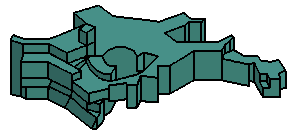 |
BUDDA on SDSS |
 |
Bulge/Disk/Bar Image Decomposition of
~ 1000 galaxies @ z ~ 0.05 in g,
r and i
TABLES
The tables with the structural parameters resulting
from the fits are separated in three groups. The first group gives the parameters as
obtained directly from the fits in each band. The second group provides colors obtained
from fits in different bands for each galaxy component, and in the third group one finds
integrated colors and magnitudes for each component. Also provided is a table with the
stellar mass-to-light ratio and mass of each component, as well as the lists of galaxies
classified as ellipticals, disk galaxies with classical bulges, disk galaxies with
pseudo-bulges, barred and unbarred galaxies, and bulgeless galaxies. A description of the
columns in each table is also given below. Surface brightness is
given in magnitudes per square arcsecond, scale lengths in kpc
(H_0 = 75 km/s/Mpc), colors in magnitudes, and masses in solar units.
The tables are simple ASCII files.
- Main parameters in each band
Column Description:
Col 1: plate
Col 2: mjd
Col 3: fiber
Col 4,5: central surface brightness of the disk, uncertainty
Col 6,7: disk scale length, uncertainty
Col 8,9: effective surface brightness of the bulge, uncertainty
Col 10,11: effective radius of the bulge, uncertainty
Col 12,13: Sérsic index of the bulge, uncertainty
Col 14,15: effective surface brightness of the bar, uncertainty
Col 16,17: effective radius of the bar, uncertainty
Col 18,19: bar ellipticity, uncertainty
Col 20,21: Sérsic index of the bar, uncertainty
Col 22,23: semi-major axis of the bar, uncertainty
Col 24,25: bar boxiness, uncertainty
Col 26: bulge-to-total ratio
Col 27: disk-to-total ratio
Col 28: bar-to-total ratio
Col 29: chi square of fit
Col 30: seeing HWHM
Col 31: redshift
Files (click to download):
Column Description:
Col 1: plate
Col 2: mjd
Col 3: fiber
Col 4,5: central color of the disk taken directly from the fit, uncertainty
Col 6,7: extrapolated color of the disk at one scale length, uncertainty
Col 8,9: color of the bulge at one effective radius taken directly from the fit, uncertainty
Col 10,11: corrected color of the bulge at one effective radius, uncertainty
Col 12,13: extrapolated central color of the bulge, uncertainty
Col 14,15: color of the bar at one effective radius taken directly from the fit, uncertainty
Col 16,17: corrected color of the bar at one effective radius, uncertainty
Col 18,19: extrapolated central color of the bar, uncertainty
Files (click to download):
Column Description:
Col 1: plate
Col 2: mjd
Col 3: fiber
Col 4: absolute total g-band magnitude of the disk
Col 5: absolute total r-band magnitude of the disk
Col 6: absolute total i-band magnitude of the disk
Col 7: absolute total g-band magnitude of the bulge
Col 8: absolute total r-band magnitude of the bulge
Col 9: absolute total i-band magnitude of the bulge
Col 10: absolute total g-band magnitude of the bar
Col 11: absolute total r-band magnitude of the bar
Col 12: absolute total i-band magnitude of the bar
Col 13: g-i total color of disk
Col 14: r-i total color of disk
Col 15: g-i total color of bulge
Col 16: r-i total color of bulge
Col 17: g-i total color of bar
Col 18: r-i total color of bar
File (click to download):
- Stellar mass-to-light ratios and masses3
Column Description:
Col 1: plate
Col 2: mjd
Col 3: fiber
Col 4: M/L of the bulge
Col 5: M/L of the disk
Col 6: M/L of the bar
Col 7: bulge mass
Col 8: disk mass
Col 9: bar mass
File (click to download):
- Galaxy, bulge and bar classification4
Column Description:
Col 1: plate
Col 2: mjd
Col 3: fiber
Files (click to download):
Notes:
1 - Colors taken directly from the fits need, in principle,
to be corrected from the fact that the effective radius of the bulge,
or the bar, in one band, might be slightly different in the other band,
due to color gradients. However, this difference is usually very small
and within seeing effects. We present colors corrected from this
effect, as well as extrapolated colors to some defined position (one
scale length in case of the disk, and the galaxy center in case of the
bulge and the bar). These quantities, however, have significantly
larger uncertainties than the colors obtained directly from the fits
(in particular those of bulge and bar extrapolated to the center)
because they depend on other structural parameters, which carry their
own uncertainties.
2 - Total absolute magnitudes and colors are obtained
directly from the model images, with no extrapolation to infinity. This
means, e.g. that the bulge total magnitude and color are calculated
within the galaxy images, which are produced in order to contain enough
sky background around the galaxy.
3 - The i-band stellar
mass-to-light ratios are derived from the integrated
g-i
colors of each component and the relation found in Kauffmann et al. (2007, ApJS 173, 357
- their Fig. 15). The stellar masses are derived using these mass-to-light ratios and the
i-band integrated luminosities of each
component. The file containing these data is a CSV file (comma-separated values) and
does have a header.
4 - Elliptical galaxies are those which do not show signs of a stellar disk component
in the image, isophotal contours and the surface brightness radial profile. Disk galaxies with
classical and pseudo-bulges are separated using the Kormendy relation. Pseudo-bulges are
outliers in the latter (Gadotti 2009, MNRAS 393, 1531 - Fig. 8). Bulgeless galaxies are those
which do not seem to have a photometric bulge, i.e. a significant central excess above the disk
surface brightness profile. Bars were identified whenever there was a typical signature in
eiher the image, isophotal contours or the surface brightness radial profile. Unbarred galaxies
here might still host bars with semi-major axis below 2-3 kpc, which are unlikely to be
identified given the relatively low spatial resolution of the SDSS images.



